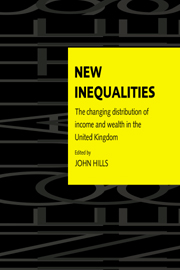1 - Introduction: after the turning point
Published online by Cambridge University Press: 22 September 2009
Summary
More than 20 years ago the then Labour government established a Royal Commission on the Distribution of Income and Wealth (RCDIW). The final reports of that commission were published in the summer of 1979. The most recent data to which it had access related to 1978 for earnings dispersion, 1977 for the distribution of household income using Family Expenditure Survey (FES) data, the financial year 1976–77 for the overall distribution of income based largely on tax records (the ‘Blue Book’ series), and 1976 for the distribution of wealth.
The picture painted by the Commission's reports was one of substantial inequalities in the distribution of income and wealth, but one where those inequalities had been narrowing. The ‘Gini coefficient’ inequality index for the distribution of post-tax income between tax units in the Blue Book series had fallen from 36.6 per cent in 1964 to 31.5 per cent in 1975–76 and 1976–77, well below its 1949 level of 35.5 per cent, indicating reduced income inequality (RCDIW, 1979, table 2.3). The ratio between the top and bottom deciles of male full-time gross weekly earnings was 2.36 in 1978 compared to 2.46 in 1970, but up slightly from 2.32 in 1977. For women the ratio had fallen to 2.34 in 1978, its lowest point in the series examined, compared to 2.57 in 1970 (RCDIW, 1979, table 2.16).
- Type
- Chapter
- Information
- New InequalitiesThe Changing Distribution of Income and Wealth in the United Kingdom, pp. 1 - 16Publisher: Cambridge University PressPrint publication year: 1996
- 3
- Cited by



